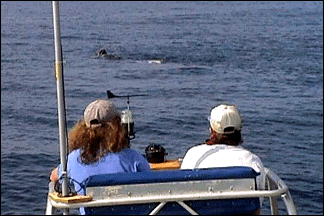

Going About it the Right Way
Gray's Reef researchers follow migratory whales
to document dwindling breed

Photo courtesy of Gray's Reef National Marine Sanctuary
Dedicated researchers spend long hours in the ocean observing
the habits of right whales in order to learn how to preserve the species.
By Margarita Venegas
(3/5/99 issue)
After weeks of uncertainty and slight concern, researchers of the National
Oceanic and Atmospheric Administration caught sight of whale No. 1612 and
her calf, only to lose her again, possibly forever.
The administration, which relied on efforts locally by Gray's Reef National Marine Sanctuary, the Georgia Department of Natural Resources and the Florida Department of Environmental Protection, started tracking the North Atlantic right whale by boat in late December. Aerial surveys, which started in 1994, take place on a staff availability schedule. Gray's Reef and the DNR rely on volunteers to fly grid patterns 750 feet above the water and search for any right whales.
Currently, there are an estimated 300 North Atlantic right whales, part of the diminishing family of right whales from the Pacific, Southern and Atlantic regions. The number of right whales is dwindling rapidly, down from approximately 1,000 several years ago.
Each year has seen a smaller number of mothers and calves in the waters off the Georgia and Florida coasts, making this year's observation and tagging efforts crucial to finding more information about what can be done to prevent right whale extinction, according to Gray's Reef Marine Educator Cathy Sakas.
This year only one whale, No. 1612, was tagged (the infant whales are left alone) and there were reports of one other mother/calf pair and a few other individual whales, said Sakas.
"Nobody wants to say that they are gone for good," Sakas said. "It could be they just haven't come down this far because of weather conditions."
The whales usually calve in the waters between Savannah and West Palm Beach, Fla., and should be on their way back home to colder northern waters now, according to Gray's Reef Planning and Outreach Coordinator Becky Shortland.
According to the National Oceanic and Atmospheric Administration, right whales got their name because whalers considered them the "right" whales to kill. Because they stay close to the surface and move slowly, they make ready targets.
The NOAA crew had been following No. 1612 and her calf by boat for 96 hours straight when storm conditions made them head back to shore. When they returned, they could not find her, even with the implanted radio transmitter, which is about the size of a human thumb.The last official sighting of No. 1612 was Jan. 29, although boaters reported another sighting to Gray's Reef a few days later.
"They said they saw her basically in the Gray's Reef area, off the coast of the island," said Marine Operations Coordinator Bruce Cowden.
Right whales are easily distinguishable because of a pattern that looks like barnacles attached to the top part of the whales' head. Loose flaps of skin attract a parasite, which breeds and forms a distinct pattern on the whales' head, this can be used to "fingerprint" the animal, Sakas said. They reach between 50-60 feet in length, have no dorsal fin, a large head, baleen, a narrow upper jaw and a strongly bowed lower jaw.
Unfortunately, their anatomical restrictions cause the whales to be slow swimmers, and their ever-dwindling numbers are due in large part to deaths from run-ins with large military and cargo ships, Cowden said.
Because right whale calves must gain about 200 pounds a day to get a thick enough layer of blubber to survive in the cold ocean waters, they often must continue feeding into the night. In the dark, ships don't have a chance to see the whales and calves, Cowden said.
"The whales can get scooped up by these ships and basically snapped in half, then they just slide back into the ocean," he said.
Sakas did a necropsy (a whale autopsy) on one that was killed in this manner, and found that on the surface, the whale seemed to be fine. Once she and fellow researchers got past the whale's blubber, they found bruising and a crushed clavicle.
Although the observation team, which was led by researchers from New England Aquarium and NOAA's Fisheries Service Office of Protected Resources, got to spend only four days watching No. 1612's behavior patterns before she disappeared, they learned much, said Sakas. With the observation officially ended, the team can now document what they saw and use it to try to figure out more ways to protect the whales.
"One of the things that came out of the observation was that there was constant contact between the mother and calf," Sakas said. The whales almost seemed to play, with the 15-ft. (and constantly growing) infant calf rolling over its mother and tagging along behind her, she said. "We just wanted to better observe the interactions because we didn't have any data on that. Even though we have a small amount of information, it's very good."
To learn more about the right whale, visit the NOAA's right whale Web site at http://www.rightwhale.noaa.gov. To report a right whale sighting, go to http://www.learner.org/cgi-bin/jnorth/jn-sightings or call Gray's Reef National Marine Sanctuary at 598-2345.
For a right whale video, handout and poster for educational use go
to http://www.graysreef.nos.noaa.gov/rwoverview.html.
Home | Contact Us | Sitemap
| FAQ | Subscribe
| Survey
(c) Copyright 1999. The Georgia Guardian. All rights
reserved.
No photo may be reproduced without our written permission.